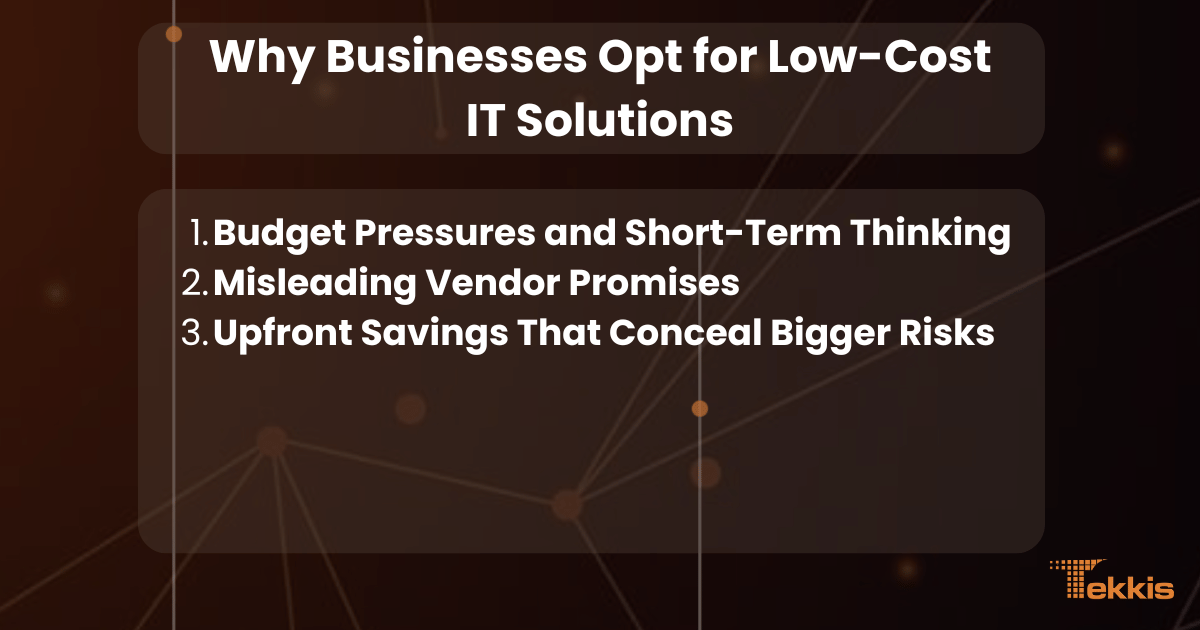The Hidden Costs of Cheap IT Hardware and Cut-Rate Cable Vendors
For businesses, the allure of saving money on IT hardware is strong. Businesses replacing aging technology infrastructure can save up to 30% initially when choosing budget options over premium alternatives. But what looks like a smart financial decision on paper often reveals itself as a costly mistake down the road. When companies cut corners on essential technology, they may unknowingly trade short-term savings for long-term expenses that far exceed the initial discount. As technology becomes increasingly central to business operations, understanding the true cost of cheap IT hardware has never been more critical.
Don't compromise on quality. Choose Tekkis for reliable and scalable IT solutions that fit your budget. Contact us today to learn how we can help you make the best technology investments for your business!
Also Read:
- Enterprise Network Architecture - A Strategic Guide
- Hacking Ethically: Master Cybersecurity Skills Now
Why Businesses Opt for Low-Cost IT Solutions

Budget Pressures and Short-Term Thinking
Limited IT budgets create tremendous pressure on businesses, particularly small and medium-sized companies in competitive markets. When faced with immediate financial constraints, the appeal of cheap computer parts and budget hardware becomes nearly irresistible. According to Data Collection Tech's 2024 TCO analysis, a typical small business allocates just 6-8% of its total budget to IT spending, making every dollar count. This financial reality often forces decision-makers to prioritize immediate savings over future considerations.
The quarterly focus many businesses operate under compounds this issue. When leadership evaluates performance on 90-day cycles, investing in premium computer hardware that might take 18-24 months to demonstrate ROI becomes a difficult sell. This short-term thinking creates an environment where securing the lowest upfront cost becomes the primary goal, regardless of potential long-term consequences.
Misleading Vendor Promises
The market for cheap electronics is flooded with enticing claims that often don't hold up under scrutiny. Vendors of budget IT hardware frequently market their products with promises of "enterprise-grade performance at consumer prices" or "99% of the quality at 50% of the cost." These misleading promises can make decision-makers believe they're getting exceptional value when the reality is quite different.
Many businesses fall victim to comparing specifications sheets without understanding the nuances of component quality. Two devices might feature processors with identical clock speeds, but significant differences in reliability, heat management, and actual performance under load remain hidden. When shopping for cheap PC components, businesses often focus on raw specifications rather than build quality, component sourcing, or testing standards.
Upfront Savings That Conceal Bigger Risks
The apparent savings from purchasing cheap or discount hardware create an accounting illusion. A business might save $300 per workstation initially, multiplied across dozens or hundreds of employees. This impressive figure makes for a compelling immediate case but conceals substantial risks lurking just beyond the purchase date.
What these calculations typically miss are the cascading costs that follow. According to Texas DIR's PC lifecycle guidelines, businesses rarely account for the higher probability of data loss, security breaches, or the productivity impact when employees struggle with subpar equipment. The math becomes even more problematic when considering the shortened replacement cycles of budget hardware. A quality workstation might function effectively for 5+ years, while cheap computer parts often require replacement in just 2-3 years, effectively doubling the lifetime cost of ownership.
The True Cost of Cheap IT Hardware
When businesses shop for computer hardware at bargain prices, the initial savings can be seductive. However, what appears as a smart financial decision often conceals a multitude of hidden expenses that accumulate over time. Looking beyond the price tag reveals how cheap IT solutions can ultimately cost significantly more than their premium counterparts.
Increased Downtime and Productivity Loss
One of the most immediate consequences of investing in cheap PC components is the increased frequency of system failures. Research from Cloudsecure Tech found that budget workstations experience up to 3 times more critical failures in their first three years compared to premium alternatives. Each instance of downtime translates directly into lost productivity across entire teams or departments.
When systems built with cheap computer parts fail, the impact extends beyond the obvious repair costs. Consider that the average employee downtime costs businesses approximately$427 per minute when accounting for wages, missed deadlines, and lost opportunities. The British Airways case study from 2017 illustrates this risk dramatically - when their IT systems failed due to inadequate backup systems, the resulting flight cancellations affected 75,000 passengers and cost the company £80 million in compensation, operational losses, and recovery efforts.
IT support teams also face increased burden responding to frequent hardware-related tickets, diverting their attention from strategic initiatives that could otherwise drive business growth. This hidden productivity drain often goes unmeasured but significantly impacts an organization's operational efficiency and innovation capacity.
Shortened Hardware Lifespan and Frequent Replacements
Budget-conscious businesses often discover that inexpensive computer parts require replacement far sooner than quality alternatives. While premium hardware typically maintains optimal performance for 4-5 years, budget equipment often degrades significantly after just 18-24 months. According toTom Geraghty's IT Hardware Lifecycle analysis, this accelerated replacement cycle effectively doubles or triples the lifetime cost of ownership.
The rapid deterioration of cheap electronics also creates significant operational disruptions. Each replacement cycle requires time for procurement, setup, data migration, and employee adjustment to new systems. These transition periods invariably result in productivity dips that compound the already higher total cost of ownership.
Environmental considerations also come into play as shortened lifespans generate more electronic waste. Organizations with sustainability commitments find themselves in the uncomfortable position of disposing of more hardware more frequently, contradicting environmental policies and potentially damaging corporate reputation among increasingly eco-conscious consumers and partners.
Poor Performance That Slows Down Operations
Perhaps the most insidious cost of budget hardware comes in the form of daily performance limitations that slowly drain organizational efficiency. Employees using workstations with bargain hardware often experience extended wait times for basic operations – from booting up in the morning to opening large files or running multiple applications simultaneously.
These small delays – 15 seconds here, 30 seconds there – accumulate dramatically over time. When multiplied across dozens or hundreds of employees over months and years, the productivity impact becomes staggering.ThinkArcoa's 2022 IT asset management study estimated that slow-performing hardware costs the average organization approximately 5.5 days of productivity per employee annually.
Additionally, as software demands inevitably increase over time, cheap components lack the headroom to accommodate evolving requirements. What functions adequately today may become painfully slow when next year's software update requires additional resources. Premium hardware, with its greater performance margins, typically handles these evolving demands far more gracefully, extending useful life and preserving employee productivity.
The Impact on Security and Compliance
While budget-friendly computer hardware prices might seem appealing for your bottom line, they often conceal serious security vulnerabilities that can expose your business to significant risk. As cybersecurity threats continue to evolve in sophistication, the security limitations of cheap IT hardware become increasingly problematic, particularly for businesses subject to regulatory compliance requirements.

Inadequate Hardware Firewalls and Vulnerability Gaps
Many businesses don't realize that budget hardware often ships with minimal security features or outdated firmware. While reputable computer hardware manufacturers typically invest in robust security testing and regular firmware updates, manufacturers of cheap PC components frequently neglect these critical security measures to reduce costs.
The Knight Capital Group case provides a stark example of the consequences. In August 2012, reliance on older, unpatched trading systems led to a software glitch causing erroneous trades worth $7 billion. Within just 45 minutes, the company suffered catastrophic losses of $440 million, wiping out 75% of its market value and eventually forcing a merger.
A concerning industry analysis revealed that budget network devices frequently contain firmware with known vulnerabilities that remain unpatched months after disclosure. These devices typically feature simplified hardware firewalls with limited packet inspection capabilities and outdated security protocols that sophisticated attacks can easily bypass.
Hardware That Fails HIPAA, PCI, or NIST Requirements
Organizations in regulated industries face particularly severe consequences when deploying cheap computer parts that don't meet compliance standards. HIPAA-covered entities risk significant penalties when patient data protection is compromised by inadequate hardware. These regulations explicitly require capabilities many budget systems lack, including robust encryption for data at rest, comprehensive audit logging capabilities, and unique user authentication features.
Similarly, businesses processing payment data must adhere to PCI DSS requirements that budget hardware typically fails to satisfy. The standard mandates specific hardware security capabilities, including secure storage mechanisms for cardholder data and support for advanced encryption protocols. When audited, organizations often discover too late that their discount equipment can't meet these requirements without costly compensatory controls.
NIST compliance frameworks present another hurdle. Government contractors and organizations following NIST SP 800-171 or 800-53 guidelines require hardware that supports advanced features like FIPS 140-2 encryption and secure maintenance protocols. Finding these capabilities in cheap electronics online is nearly impossible, as these features require specialized hardware components and rigorous security testing that budget manufacturers typically skip.
Long-Term Exposure to Cyber Threats
Perhaps most concerning is how budget hardware creates lasting security vulnerabilities that mature over time. When manufacturers of inexpensive equipment discontinue security support earlier than premium vendors, systems remain in production with known, unpatched vulnerabilities.Storvix's TCO infrastructure analysis found that budget networking equipment typically received security updates for just 3-4 years, compared to 7+ years for enterprise-grade alternatives.
This shortened support window creates a dangerous scenario where businesses face a difficult choice: replace functional but vulnerable equipment prematurely or accept increased cybersecurity risk. The RBS/NatWest Banking Group case demonstrates this risk – the banking giant had historically underinvested in its IT systems, resulting in a major IT failure that left millions of customers unable to access accounts. The incident cost the group £56 million in fines and compensation, with additional reputational losses in the millions.
TCO Comparison: Budget vs. Premium Hardware
When evaluating IT hardware options, comparing the total cost of ownership (TCO) over a standard 5-year period reveals significant differences between budget and premium solutions. The following table illustrates how the financial equation changes when considering all cost factors for a typical 50-employee business:

5-Year TCO Breakdown (Per Device)
| Cost Factor | Budget Hardware | Premium Hardware |
|---|---|---|
| Initial Purchase | $700 | $1,200 |
| Annual Maintenance (avg) | $105-$140 (15-20% of purchase price) | $60-$120 (5-10% of purchase price) |
| Productivity Impact (annually) | $1,100 (based on average downtime) | $300 (reduced downtime) |
| Replacement Cycle | Every 2-3 years | Every 4-5 years |
| Energy Consumption | Higher (older components) | Lower (more efficient) |
| Residual Value | Minimal (5-10%) | Moderate (25%) |
| 5-Year Total Cost | $5,600-$7,200 | $3,800-$4,900 |
As this comparison demonstrates, premium hardware typically delivers 25-40% lower TCO over a 5-year period despite the higher initial investment. These figures align with our experience at Tekkis, where clients consistently see better long-term value with quality hardware investments.
How to Evaluate IT Vendors and Hardware the Smart Way
When making IT hardware purchasing decisions, it's essential to look beyond the initial price and evaluate the total value proposition. Here’s how to effectively assess IT vendors and hardware options for long-term benefits.
Start by considering vendors' reputation and market stability. Established companies with proven track records often offer more reliable products and better support. Look for industry reviews, customer references from similar businesses, and their history of consistent quality.
Scrutinize technical capabilities beyond basic specs. Assess how hardware performs under real-world workloads relevant to your applications. Premium hardware may include features like enhanced security, professional-grade components, and management tools that lower administrative costs—advantages not typically found in budget options.
Support services are another critical factor. Investigate post-sale support: responsiveness of technical support, availability of replacement parts, and service options. Premium vendors usually provide more comprehensive support, minimizing downtime during critical failures.
Total Cost of Ownership (TCO) calculations give a clearer picture of hardware value. Consider all lifecycle expenses—purchase, implementation, maintenance, energy use, and productivity impacts. Premium hardware may have higher upfront costs but often results in lower TCO due to reduced maintenance, energy efficiency, enhanced productivity, and longer service life.
Conclusion: Making Smart IT Investments for Long-Term Success
True cost-effective IT procurement requires looking beyond initial purchase prices to evaluate the complete lifecycle impact of hardware investments. When businesses properly account for factors like increased downtime, shortened hardware lifespan, productivity losses, security vulnerabilities, and compliance risks, the value proposition of premium hardware becomes much clearer. The decision to invest in quality technology represents a strategic choice that acknowledges IT as a business enabler rather than merely a cost center.
At Tekkis, we help businesses navigate these complex decisions by providing comprehensive TCO analyses, security evaluations, and strategic guidance for technology investments. Our experience consistently shows that organizations investing in quality IT hardware enjoy better reliability, improved employee productivity, and lower total costs over time.
Ready to make smarter IT hardware decisions?
Contact our team at Tekkis for a complimentary IT infrastructure assessment. We'll help you evaluate your current equipment, identify potential vulnerability points, and develop a strategic hardware procurement plan that balances immediate budget considerations with long-term value.
Schedule your assessment today by visiting www.tekkis.com/get-started to learn how quality IT investments can drive your business forward.



